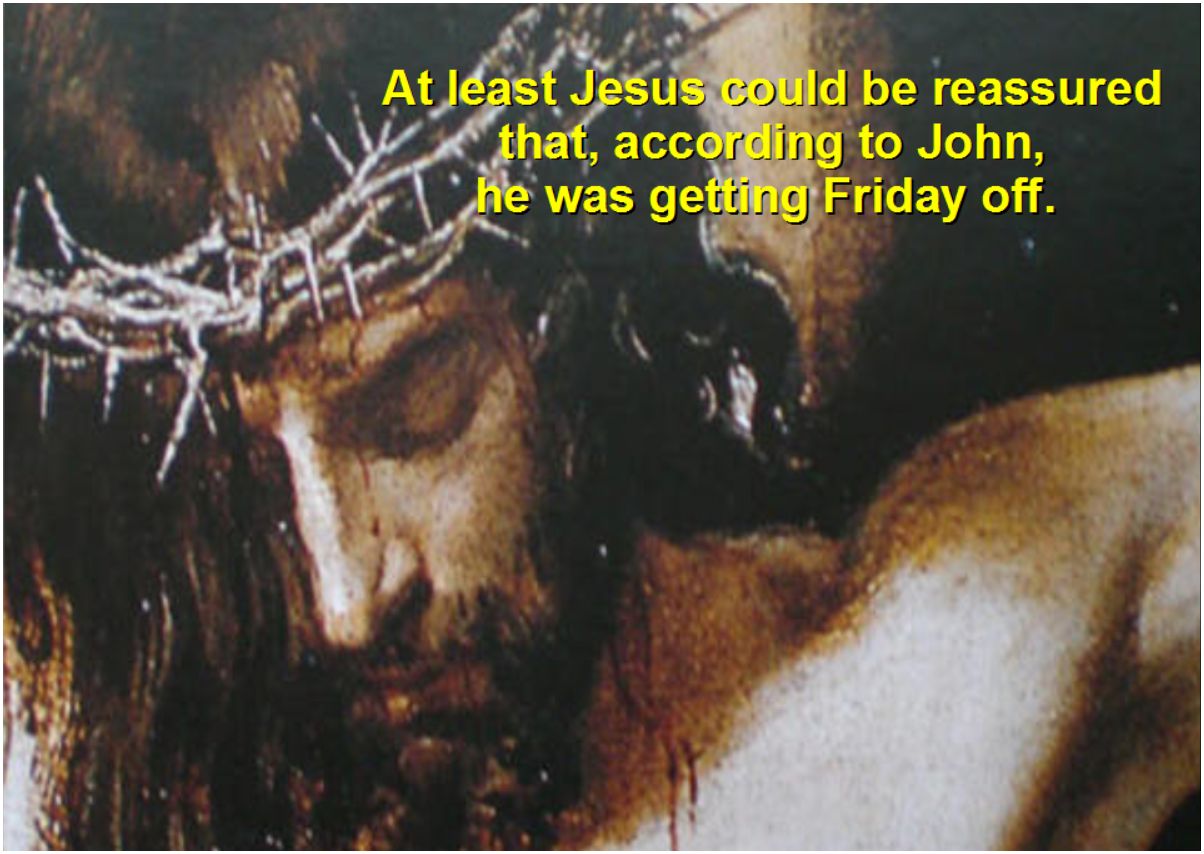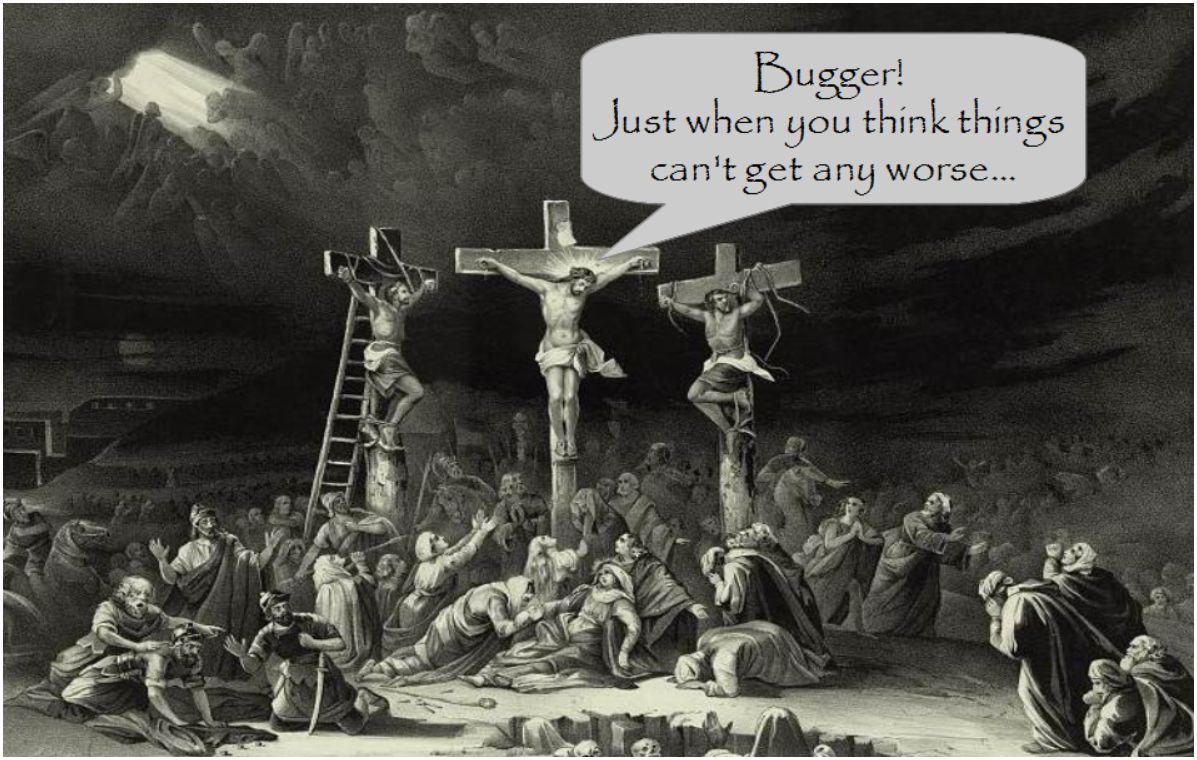
Mark 15 tells the story of the trial, crucifixion and burial of Jesus. Here’s how it was constructed from parts of the Old Testament:
Isaiah 53:7 is rewritten in Mark 15: 60-62 as the trial before Pilate
He was oppressed and afflicted, yet He did not open His mouth. He was led like a lamb to the slaughter, and as a sheep before her shearers is silent, so He did not open His mouth.
So Pilate questioned him, “Are You the King of the Jews?” “You have said so,” Jesus replied. And the chief priests began to accuse him of many things. Then Pilate questioned him again, “Have you no answer? Look how many charges they are bringing against you!” But to Pilate’s amazement, Jesus made no further reply.
(Oops! Looks like we are expected to overlook the fact that Jesus does speak! Mark obviously had trouble shoe-horning this one in!)
——————————–
Isaiah 53.5 becomes Mark 15:15:
He was crushed for our iniquities; the punishment that brought us peace was upon him, and by his stripes we are healed.
Pilate had Jesus flogged and handed him over to be crucified.
——————————–
Isaiah 50:6 and 53:16-20 are rewritten as Mark 15:16-20:
He was despised and rejected by mankind, a man of suffering, and familiar with pain. Like one from whom people hide their faces he was despised, and we held him in low esteem.
Then the soldiers led Jesus away into the palace (that is, the Praetorium) and called the whole company together. They dressed him in a purple robe, twisted together a crown of thorns, and set it on his head. And they began to salute Him: “Hail, King of the Jews!” They kept striking his head with a staff and spitting on him. And they knelt down and bowed before him. After they had mocked him, they removed the purple robe and put his own clothes back on Him. Then they led Him out to crucify Him.
——————————–
Psalm 22:18 becomes Mark 15:24
They divide my clothes among them and cast lots for my garment.
And they crucified him. Dividing up his clothes, they cast lots to see what each would get.
——————————–
Isaiah 53:12 is used for Mark 15:27:
He poured out his life unto death, and was numbered with the transgressors.
Along with Jesus, they crucified two robbers, one on His right and one on His left.
——————————–
Psalm 22:7-8 becomes, verbatim in places, Mark 15:29:
All who see me mock me; they hurl insults shaking their heads: He trusts in the Lord; let the Lord rescue him. Let him deliver him, since he delights in him.
Those who passed by hurled insults at him, shaking their heads and saying, “So! You who are going to destroy the temple and build it in three days, come down from the cross and save yourself!”
——————————–
Psalm 22:1 ‘My God, my God why have you forsaken me?’ is lifted straight into Mark 15:34.
——————————–
Isaiah 53:5 becomes the underpinning of the whole of this chapter and Mark 15:6-15 in particular: the story of Barabbas.
Surely he took up our pain and bore our suffering, yet we considered him punished by God, stricken by him, and afflicted. But he was pierced for our transgressions, he was crushed for our iniquities; the punishment that brought us peace was on him, and by his stripes/wounds we are healed.
The verses are not alluded to directly, but Jesus is made to stand in for Barabbas (literally, ‘son of the father’) who has deservedly been sentenced to death, or so Mark would have us believe. The story is patently invented to make this point. No such tradition existed and Pilate would never have been so placatory. The other made up story in Mark 15, the tearing of the temple veil, symbolises that the old way of accessing God, though the temple system, had now been superseded by… who else? Jesus. Ironic really when Mark plunders that old system’s scriptures for his purposes.
——————————–
Isaiah 53:9 is written up as Mark 15.43-46
He was assigned a grave with the wicked, and with the rich in his death,
though he had done no violence, nor was any deceit in his mouth.
Joseph of Arimathea, a prominent member of the Council, who was himself waiting for the kingdom of God, went boldly to Pilate and asked for Jesus’ body... Pilate gave the body to Joseph. So Joseph bought some linen cloth, took down the body, wrapped it in the linen, and placed it in a tomb cut out of rock.
——————————–
Mark 15: all of it constructed from the OT or just plain made up. You could, like gullible Christians, insist that Mark didn’t invent his story using fragments of scripture. You could say instead that these fragments were really prophecies of incidents that were to happen in the life of an itinerant preacher many years in the future. You could argue that the probably non-existent creator of the universe was all the time controlling events, dropping into ancient scriptures veiled references to tenuously connected incidents centuries later. But then you’d have to concede that not one of them is precise enough to name Jesus or indicate he’d die by crucifixion or would return from the dead after a day and a half.
Which seems to you more likely? That imprecise ‘prophecies’, which really weren’t prophecies in the first place, came true in Jesus’ life; or that Mark lifted scriptures which suited his purpose and crafted his Jesus story around them?
For me, it’s always a case of ‘seek ye first the human contrivance’, by far the most plausible and persuasive explanation of scenarios such as this.






